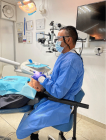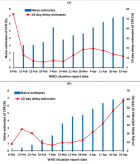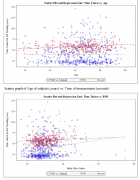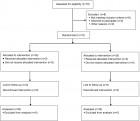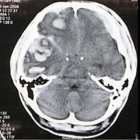Abstract
Research Article
CVS: An Effective Strategy to Prevent Bile Duct Injury
Sardar Rezaul Islam*, Debabrata Paul, Shah Alam Sarkar, Mohammad Hanif Emon and Tania Ahmed
Published: 02 April, 2024 | Volume 8 - Issue 1 | Pages: 027-031
Background: Bile duct injuries have been substantially increased after the introduction of laparoscopic cholecystectomy (LC). These are accompanied by major morbidity and mortality. Studies have shown varying degrees of success in the reduction of bile duct injury (BDI) using the Critical View of Safety (CVS) technique. The aim of this study was to see the efficacy of the CVS technique as the sole method of dissection in laparoscopic cholecystectomy.
Methods: 1647 cases of LC were done between January 2012 and January 2022 for a period of 10 years in two hospitals. All were operated by the CVS dissection technique and none by the infundibular technique. Cases included acute cholecystitis, chronic cholecystitis, gangrenous cholecystitis, empyema, and Gallbladder (GB) polyp.
Results: The average operating time was 42 minutes and the range was 13 to 80 minutes. In 92% of cases, all 3 criteria of CVS were achieved. In the remaining 8% cases were either converted to open or operated by a division of GB or subtotal cholecystectomy was done. There was only one case of cystic duct stump leak requiring drainage and common bile duct stenting.
Conclusion: The excellent outcome of our study suggests that the CVS method will be the gold standard technique in the dissection of the gallbladder in LC. Further dissemination of the technique is necessary to improve safety in LC.
Read Full Article HTML DOI: 10.29328/journal.ascr.1001080 Cite this Article Read Full Article PDF
Keywords:
Bile duct injury; Laparoscopic cholecystectomy; Critical view of safety; Infundibular technique
References
- Steven M. Strasberg A perspective on the critical view of safety in laparoscopic cholecystectomy. Annals of Laparoscopic and Endoscopic Surgery. doi: 10.21037/ales.2017.04.08
- Strasberg SM, Pucci MJ, Brunt LM, Deziel DJ. Subtotal Cholecystectomy-"Fenestrating" vs "Reconstituting" Subtypes and the Prevention of Bile Duct Injury: Definition of the Optimal Procedure in Difficult Operative Conditions. J Am Coll Surg. 2016 Jan;222(1):89-96. doi: 10.1016/j.jamcollsurg.2015.09.019. Epub 2015 Oct 9. PMID: 26521077.
- Avgerinos C, Kelgiorgi D, Touloumis Z, Baltatzi L, Dervenis C. One thousand laparoscopic cholecystectomies in a single surgical unit using the "critical view of safety" technique. J Gastrointest Surg. 2009 Mar;13(3):498-503. doi: 10.1007/s11605-008-0748-8. Epub 2008 Nov 14. PMID: 19009323.
- Yegiyants S, Collins JC. Operative strategy can reduce the incidence of major bile duct injury in laparoscopic cholecystectomy. Am Surg. 2008 Oct;74(10):985-7. PMID: 18942628.
- Vettoretto N, Saronni C, Harbi A, Balestra L, Taglietti L, Giovanetti M. Critical view of safety during laparoscopic cholecystectomy. J Soc Laparoendosc Surg. 2011; 15(3):322. doi:10.4293/108680811X13071180407474.
- Viswanathan V, Garg HP. Critical view of safety technique during laparoscopic cholecystectomy in prevention of biliary injuries. Int J Int Med Res.2016; 3(4):35–40.
- Lam T, Usatoff V, Chan ST. Are we getting the critical view? A prospective study of photographic documentation during laparoscopic cholecystectomy. HPB (Oxford). 2014 Sep;16(9):859-63. doi: 10.1111/hpb.12243. Epub 2014 Mar 17. PMID: 24635851; PMCID: PMC4159460.
- Manatakis DK, Vitalis A, Agalianos C, Terzis I, Kyriazanos ID, Davides D. Teaching and learning the critical view of safety technique in laparoscopic cholecystectomy. 2016; 18:e664–e665. doi:10.1016/j. hpb.2016.01.007.
- Nuzzo G, Giuliante F, Giovannini I, Ardito F, D'Acapito F, Vellone M, Murazio M, Capelli G. Bile duct injury during laparoscopic cholecystectomy: results of an Italian national survey on 56 591 cholecystectomies. Arch Surg. 2005 Oct;140(10):986-92. doi: 10.1001/archsurg.140.10.986. PMID: 16230550.
- Waage A, Nilsson M. Iatrogenic bile duct injury: a population-based study of 152 776 cholecystectomies in the Swedish Inpatient Registry. Arch Surg. 2006 Dec;141(12):1207-13. doi: 10.1001/archsurg.141.12.1207. PMID: 17178963.
- Martin D, Uldry E, Demartines N, Halkic N. Bile duct injuries after laparoscopic cholecystectomy: 11-year experience in a tertiary center. Biosci Trends. 2016 Jul 19;10(3):197-201. doi: 10.5582/bst.2016.01065. Epub 2016 Jun 17. PMID: 27319974.
- Eikermann M, Siegel R, Broeders I, Dziri C, Fingerhut A, Gutt C, Jaschinski T, Nassar A, Paganini AM, Pieper D, Targarona E, Schrewe M, Shamiyeh A, Strik M, Neugebauer EA; European Association for Endoscopic Surgery. Prevention and treatment of bile duct injuries during laparoscopic cholecystectomy: the clinical practice guidelines of the European Association for Endoscopic Surgery (EAES). Surg Endosc. 2012 Nov;26(11):3003-39. doi: 10.1007/s00464-012-2511-1. Epub 2012 Oct 6. PMID: 23052493.
- Kaya B, Fersahoglu MM, Kilic F, Onur E, Memisoglu K. Importance of critical view of safety in laparoscopic cholecystectomy: a survey of 120 serial patients, with no incidence of complications. Ann Hepatobiliary Pancreat Surg. 2017 Feb;21(1):17-20. doi: 10.14701/ahbps.2017.21.1.17. Epub 2017 Feb 28. PMID: 28317041; PMCID: PMC5353907.
- Almutairi AF, Hussain YA. Triangle of safety technique: a new approach to laparoscopic cholecystectomy. HPB Surg. 2009;2009:476159. doi: 10.1155/2009/476159. Epub 2009 Jun 17. PMID: 19547662; PMCID: PMC2699444.
- Yegiyants S, Collins JC. Operative strategy can reduce the incidence of major bile duct injury in laparoscopic cholecystectomy. Am Surg. 2008 Oct;74(10):985-7. PMID: 18942628.
- Heistermann HP, Tobusch A, Palmes D. Der ''Sicherheits-Blic'' als Beitrag zur Risikoreduktion bei der laparoskopischen Cholezystektomie [Prevention of bile duct injuries after laparoscopic cholecystectomy. "The critical view of safety"]. Zentralbl Chir. 2006 Dec;131(6):460-5. German. doi: 10.1055/s-2006-957031. PMID: 17206564.
- Misra M, Schiff J, Rendon G, Rothschild J, Schwaitzberg S. Laparoscopic cholecystectomy after the learning curve: what should we expect? Surg Endosc. 2005 Sep;19(9):1266-71. doi: 10.1007/s00464-004-8919-5. Epub 2005 Jul 21. PMID: 16021365.
- Sanjay P, Fulke JL, Exon DJ. 'Critical view of safety' as an alternative to routine intraoperative cholangiography during laparoscopic cholecystectomy for acute biliary pathology. J Gastrointest Surg. 2010 Aug;14(8):1280-4. doi: 10.1007/s11605-010-1251-6. Epub 2010 Jun 10. PMID: 20535578.
- Daly SC, Deziel DJ, Li X, Thaqi M, Millikan KW, Myers JA, Bonomo S, Luu MB. Current practices in biliary surgery: Do we practice what we teach? Surg Endosc. 2016 Aug;30(8):3345-50. doi: 10.1007/s00464-015-4609-8. Epub 2015 Nov 5. PMID: 26541721.
- Chen CB, Palazzo F, Doane SM, Winter JM, Lavu H, Chojnacki KA, Rosato EL, Yeo CJ, Pucci MJ. Increasing resident utilization and recognition of the critical view of safety during laparoscopic cholecystectomy: a pilot study from an academic medical center. Surg Endosc. 2017 Apr;31(4):1627-1635. doi: 10.1007/s00464-016-5150-0. Epub 2016 Aug 5. PMID: 27495348.
Figures:
Similar Articles
-
Laparoscopic Cholecystectomy: Challenges faced by beginners our perspectiveKunal Chowdhary,Gurinder Kaur,Kapil Sindhu,Muzzafar Zaman*,Aliya Shah,Rohit Dang,Ashish Kumar,Jose John Maiakal,Ashutosh Bawa. Laparoscopic Cholecystectomy: Challenges faced by beginners our perspective. . 2018 doi: 10.29328/journal.ascr.1001018; 2: 018-024
-
Iarogenic Bile Duct Injuries: Repairs FeasibilityMS Abdelhamid*,TM Nabil,AM Rashad,SS Soliman,TM EL-Gaabary. Iarogenic Bile Duct Injuries: Repairs Feasibility. . 2019 doi: 10.29328/journal.ascr.1001023; 3: 001-004
-
Risk definition in Laparoscopic versus Open CholecystectomyMS Abdelhamid*,TM Nabil, HA Nafady,AZ Garib,SS Soliman. Risk definition in Laparoscopic versus Open Cholecystectomy. . 2019 doi: 10.29328/journal.ascr.1001027; 3: 022-026
-
Hot cholecystectomyEsam Aboutaleb*. Hot cholecystectomy. . 2019 doi: 10.29328/journal.ascr.1001040; 3: 077-077
-
Anticipation of difficulty during laparoscopic cholecystectomyMohamed Salah Abdelhamid*,Ahmed Zaki Gharib,Mohammed Abdelaal Mohammed , Mahmoud Negida. Anticipation of difficulty during laparoscopic cholecystectomy. . 2020 doi: 10.29328/journal.ascr.1001048; 4: 024-028
-
Cholecysto-colonic fistula after xanthogranulomatous cholecystitis: Surgeon’s nightmareKaran Agarwal,Badareesh Lakshminarayana*. Cholecysto-colonic fistula after xanthogranulomatous cholecystitis: Surgeon’s nightmare. . 2021 doi: 10.29328/journal.ascr.1001057; 5: 004-006
-
CVS: An Effective Strategy to Prevent Bile Duct InjurySardar Rezaul Islam*, Debabrata Paul, Shah Alam Sarkar, Mohammad Hanif Emon, Tania Ahmed. CVS: An Effective Strategy to Prevent Bile Duct Injury. . 2024 doi: 10.29328/journal.ascr.1001080; 8: 027-031
Recently Viewed
-
Cystoid Macular Oedema Secondary to Bimatoprost in a Patient with Primary Open Angle GlaucomaKonstantinos Kyratzoglou*,Katie Morton. Cystoid Macular Oedema Secondary to Bimatoprost in a Patient with Primary Open Angle Glaucoma. Int J Clin Exp Ophthalmol. 2025: doi: 10.29328/journal.ijceo.1001059; 9: 001-003
-
Metastatic Brain Melanoma: A Rare Case with Review of LiteratureNeha Singh,Gaurav Raj,Akshay Kumar,Deepak Kumar Singh,Shivansh Dixit,Kaustubh Gupta*. Metastatic Brain Melanoma: A Rare Case with Review of Literature. J Radiol Oncol. 2025: doi: ; 9: 050-053
-
Depression as a civilization-deformed adaptation and defence mechanismBohdan Wasilewski*,Olha Yourtsenyuk,Eugene Egan. Depression as a civilization-deformed adaptation and defence mechanism. Insights Depress Anxiety. 2020: doi: 10.29328/journal.ida.1001013; 4: 008-011
-
Drinking-water Quality Assessment in Selective Schools from the Mount LebanonWalaa Diab, Mona Farhat, Marwa Rammal, Chaden Moussa Haidar*, Ali Yaacoub, Alaa Hamzeh. Drinking-water Quality Assessment in Selective Schools from the Mount Lebanon. Ann Civil Environ Eng. 2024: doi: 10.29328/journal.acee.1001061; 8: 018-024
-
Rapid Microbial Growth in Reusable Drinking Water BottlesQishan Liu*,Hongjun Liu. Rapid Microbial Growth in Reusable Drinking Water Bottles. Ann Civil Environ Eng. 2017: doi: 10.29328/journal.acee.1001007; 1: 055-062
Most Viewed
-
Evaluation of Biostimulants Based on Recovered Protein Hydrolysates from Animal By-products as Plant Growth EnhancersH Pérez-Aguilar*, M Lacruz-Asaro, F Arán-Ais. Evaluation of Biostimulants Based on Recovered Protein Hydrolysates from Animal By-products as Plant Growth Enhancers. J Plant Sci Phytopathol. 2023 doi: 10.29328/journal.jpsp.1001104; 7: 042-047
-
Sinonasal Myxoma Extending into the Orbit in a 4-Year Old: A Case PresentationJulian A Purrinos*, Ramzi Younis. Sinonasal Myxoma Extending into the Orbit in a 4-Year Old: A Case Presentation. Arch Case Rep. 2024 doi: 10.29328/journal.acr.1001099; 8: 075-077
-
Feasibility study of magnetic sensing for detecting single-neuron action potentialsDenis Tonini,Kai Wu,Renata Saha,Jian-Ping Wang*. Feasibility study of magnetic sensing for detecting single-neuron action potentials. Ann Biomed Sci Eng. 2022 doi: 10.29328/journal.abse.1001018; 6: 019-029
-
Pediatric Dysgerminoma: Unveiling a Rare Ovarian TumorFaten Limaiem*, Khalil Saffar, Ahmed Halouani. Pediatric Dysgerminoma: Unveiling a Rare Ovarian Tumor. Arch Case Rep. 2024 doi: 10.29328/journal.acr.1001087; 8: 010-013
-
Physical activity can change the physiological and psychological circumstances during COVID-19 pandemic: A narrative reviewKhashayar Maroufi*. Physical activity can change the physiological and psychological circumstances during COVID-19 pandemic: A narrative review. J Sports Med Ther. 2021 doi: 10.29328/journal.jsmt.1001051; 6: 001-007

HSPI: We're glad you're here. Please click "create a new Query" if you are a new visitor to our website and need further information from us.
If you are already a member of our network and need to keep track of any developments regarding a question you have already submitted, click "take me to my Query."









